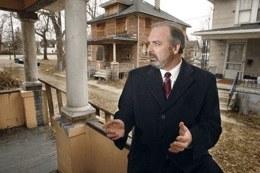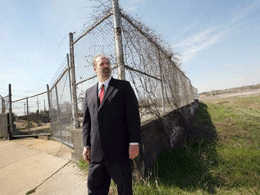Raze to Save
Air Date: Week of July 3, 2009

Dan Kildee visits one of Flint’s many underpopulated neighborhoods.
Flint, Michigan is in trouble. Half the population has skipped town and the remaining residents are surrounded by decrepit, empty homes. Now the town has a solution to fight the blight - bulldoze the dead parts and consolidate the living. Genesee County Treasurer Dan Kildee tells host Steve Curwood how this plan will save Flint and other depressed cities across America.
Transcript
YOUNG: It’s Living on Earth, I’m Jeff Young.
CURWOOD: And I’m Steve Curwood.
Bigger no longer means better -- at least not for Flint, Michigan. What was a thriving city in the heyday of General Motors is now torn by severe unemployment and abandoned houses. Flint’s population is now half of what it was, and more and more people pack up and leave every day.
With the tax base melting like ice on a hot summer day, Dan Kildee, a lifelong city resident who also is county treasurer, came up with a novel idea - how about organizing the downsizing of Flint in ways that revitalize and green the community? He’s on the line now, so Dan, please, can you take us first for a virtual walk around the North End of Flint—what would we see?
KILDEE: What you’d see is you’d see pockets of really strong neighborhoods—you know, four, five houses or even three or four blocks, maybe five blocks in a row, where everybody’s doing their best and they’re trying and they’re keeping their neighborhood together, and then you’ll run into a street with one or two houses occupied, and maybe four, five or eight or ten abandoned houses, and then a bunch of abandoned lots in between.
And there doesn’t seem to be any real order to it. And so the problem is, the people who live close to that abandonment, they have a life that just isn’t—it’s not fair to them. It’s not fair that they’ve invested their lives and their money in their house, and because of things well beyond their control, they’re surrounded now, really by a lot of ugly property. So that’s really what we’re trying to get at.
CURWOOD: So, how do you win over residents? If you look there, at the North End—the North Side of Flint, this is largely a community of color. And you folks who are talking about this, are largely the white governing structure. How have they gotten involved in this planning process today?
KILDEE: When I first started thinking about this, I was a little worried about mentioning this idea of planned shrinkage in certain areas. Let me tell you—the people who live in the neighborhood, they’re way ahead of us. They know it’s more about helping them on their own street, in their own neighborhood. There’s gotta be a high degree of public participation, in a very public planning process, that leads to this ultimate design. That’s one.
Second: not one person should ever lose their house if they don’t want to. One hundred percent voluntary is the only way this can work. So I want them to have a choice: stay where you are and be surrounded by something more beautiful, but it’s a low density environment, it’s not the urban environment or take that value that you have invested in your property and transfer it into a neighborhood that we can sustain, that looks a lot more like the neighborhood maybe that you grew up in.
CURWOOD: I want to visualize this. I mean, if you knock down a house, it just makes a vacant lot. What do you do to rehabilitate this land to make it more attractive?
KILDEE: Well we have a number of things we do. In some cases we simply let the land go back to nature. Nature does wonderful things, takes something that’s ugly and turns it into natural beauty. Sometimes nature needs a little help though. And in those cases we can bring in wildflower seeds, we can bring in trees, we can actually engage the neighbors.

The bulldozed areas will be returned to nature.
CURWOOD: So most of the time cities reclaim vacant land and they do so to develop on. So you’re doing un-development, huh? Some might think that’s backwards.
KILDEE: Well, you know, I think one of the things that is not well understood is that because a city is becoming smaller does not mean we don’t do new development. One of the things that surprises people most when they hear our story, is to learn that right in our downtown, in the center of Flint which had been forgotten essentially, you know, almost a ghost town for a while.
Just in the last year we’ve had a $100,000,000 of new construction. It’s not so much that we don’t do development, but we do development with an aim toward creating a much more compact and sustainable downtown, and then a much more carefully designed collection of neighborhoods that no matter what happens in ten or fifteen or twenty years, we can still count on those neighborhoods being there.
CURWOOD: So as I understand it, tearing down abandoned buildings in Flint isn’t especially new. Tell me about the Land Bank?

Dan Kildee visits one of Flint’s many underpopulated neighborhoods.
CURWOOD: Where does the money come from?
KILDEE: The money interestingly enough comes from the very same process that used to enrich those infomercial-watching speculators. You know, if you stay up too late at night and watch television you can see these odd infomercials that explain how to invest in these tax sale properties.
CURWOOD: Oh yes “You can make millions of dollars with turned over foreclosed property from the government.”
KILDEE: [laughing] Exactly.
CURWOOD: “Here’s a list. Just call this number now”
KILDEE: Exactly. I go to Wall Street every year. I borrow the money that is owed from all those delinquent taxpayers, give it to all the local governments and then I collect that high rate of interest that people pay for their delinquent taxes. I borrow money at three percent. I collect it at eighteen percent. The spread gives me money to invest in rehabilitation and the houses that we can rehabilitate.
CURWOOD: So you started this Land Bank seven years ago. What’s new about what you’re proposing now?
KILDEE: Its really the strong need for a new master plan. If we had a new design for our city that acknowledges that we’re smaller, then when we acquire property, we know where we should demolish, were we should rehabilitate, where the gardens should go, where the new meadow should be, where streets should be rebuilt or perhaps where they should be allowed to go back to nature. It would allow us to be much more wise and much more careful about how we make investment.
CURWOOD: Who else could benefit from this?
KILDEE: Well, I think virtually every city could, but the smart cities that will use these tools are the cities that only have a little bit of worry about this kind of decline that we’re facing. So I encourage cities that are not facing wholesale decline to think differently about their urban landscape and don’t sit on the sidelines. Get in the game. Get control of those few blighted properties at the earliest point to prevent contagious blight which like any, you know, sort of unchecked disease can wipe out whole neighborhoods in just a decade.
And I make that point by saying this: If somebody would have, you know, sort have sat down the leaders of Flint thirty five years ago and told them what would happen if we just sort of sat on the sidelines and let things run their course, we probably would have come up with this very same tool that we’ve developed. And it would have worked better. It would have been a lot easier.
CURWOOD: Dan Kildee is the Genesee County treasurer and Land Bank chairmen in Flint, Michigan. Thanks so much, Dan.
KILDEE: Thank you very much. I enjoyed it.
[MUSIC: Jake Shimabukuro “Thriller” from Live (Hitchike Records 2009)]
Links
Living on Earth wants to hear from you!
Living on Earth
62 Calef Highway, Suite 212
Lee, NH 03861
Telephone: 617-287-4121
E-mail: comments@loe.org
Newsletter [Click here]
Donate to Living on Earth!
Living on Earth is an independent media program and relies entirely on contributions from listeners and institutions supporting public service. Please donate now to preserve an independent environmental voice.
NewsletterLiving on Earth offers a weekly delivery of the show's rundown to your mailbox. Sign up for our newsletter today!
 Sailors For The Sea: Be the change you want to sea.
Sailors For The Sea: Be the change you want to sea.
 The Grantham Foundation for the Protection of the Environment: Committed to protecting and improving the health of the global environment.
The Grantham Foundation for the Protection of the Environment: Committed to protecting and improving the health of the global environment.
 Contribute to Living on Earth and receive, as our gift to you, an archival print of one of Mark Seth Lender's extraordinary wildlife photographs. Follow the link to see Mark's current collection of photographs.
Contribute to Living on Earth and receive, as our gift to you, an archival print of one of Mark Seth Lender's extraordinary wildlife photographs. Follow the link to see Mark's current collection of photographs.
 Buy a signed copy of Mark Seth Lender's book Smeagull the Seagull & support Living on Earth
Buy a signed copy of Mark Seth Lender's book Smeagull the Seagull & support Living on Earth

